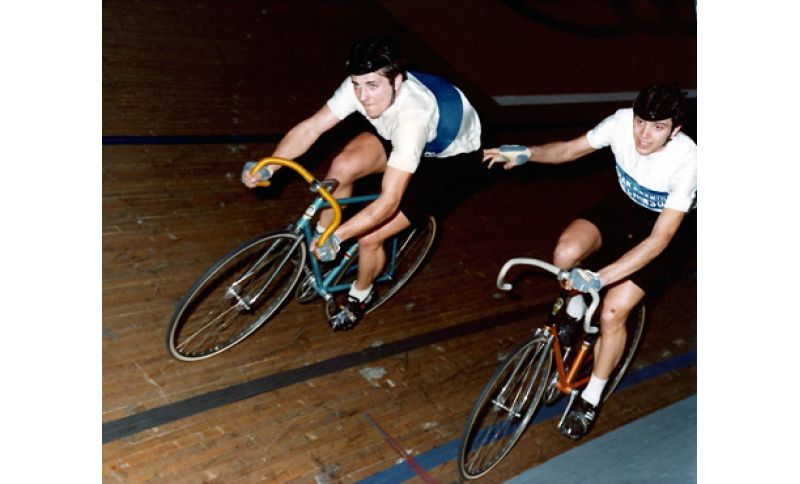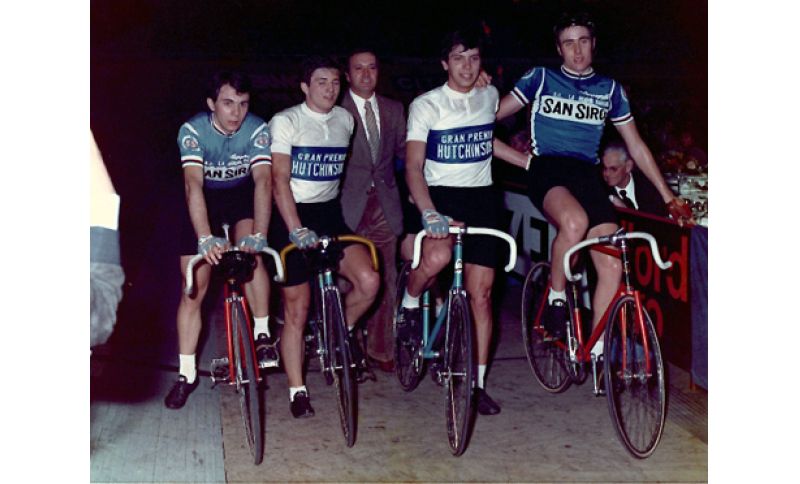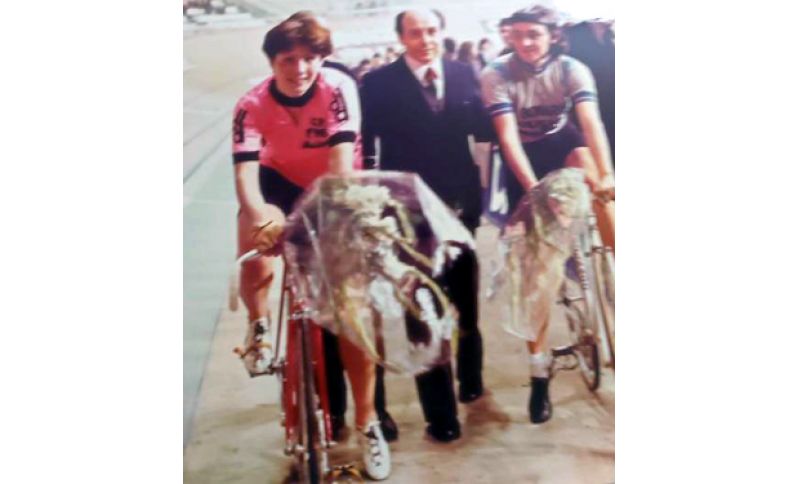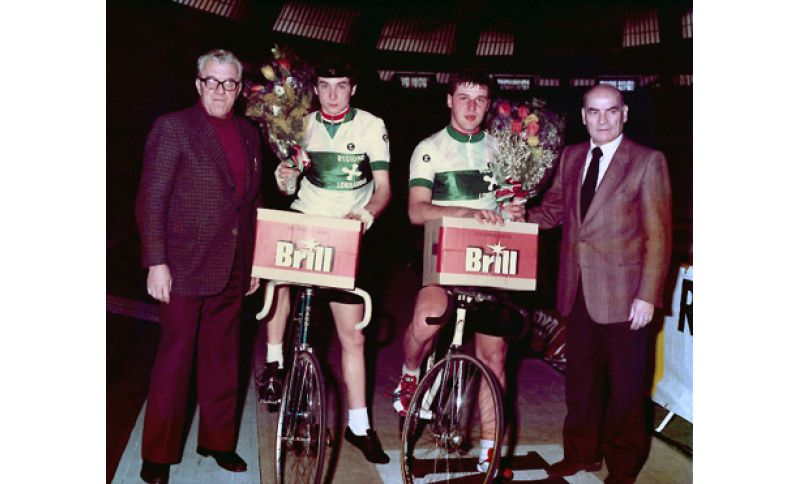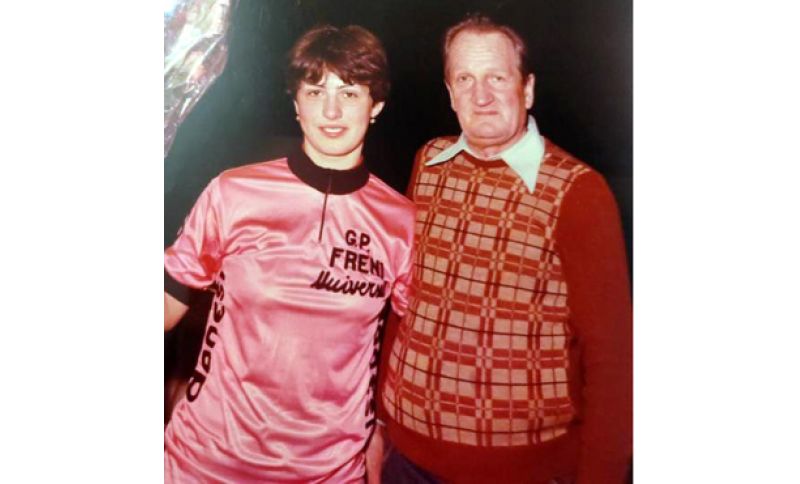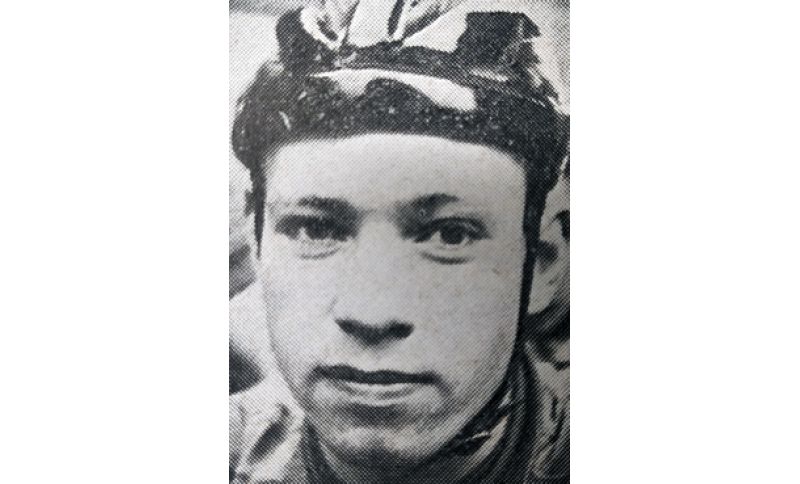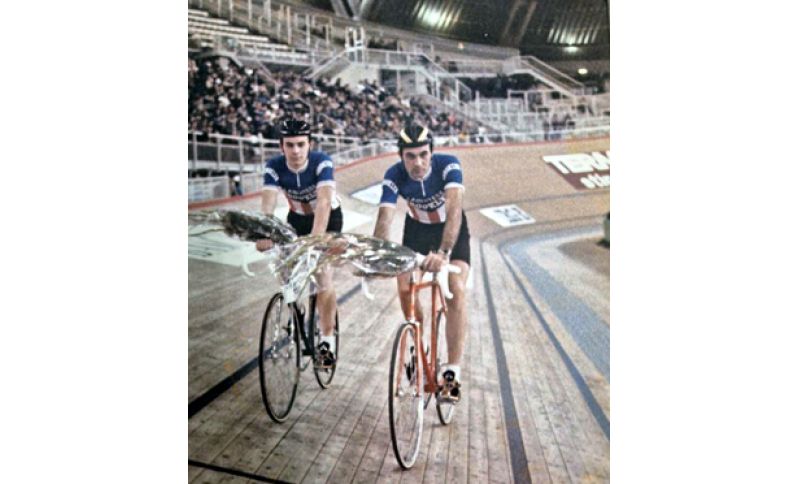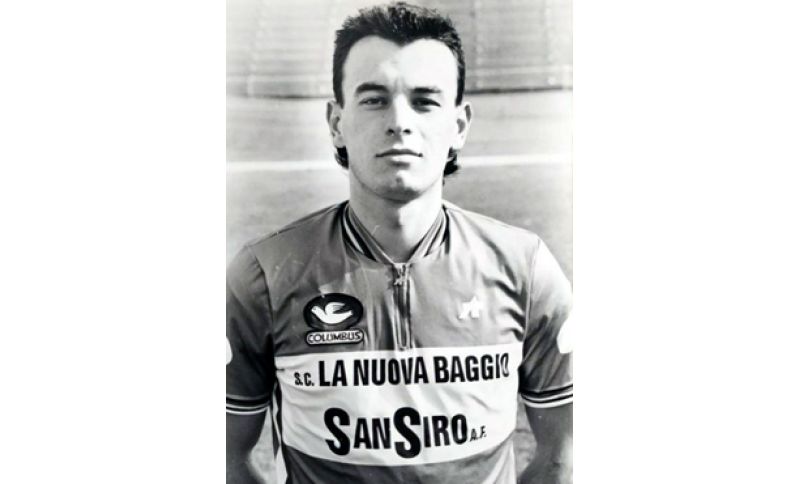HISTORY | 17/01/2025 | 08:15
di Danilo Viganò
The history of Italian cycling is rich with races that are no longer held but have made history: that's why we thought of offering you a new column that pulls them out of the memory drawer. If you have an archive photo in a drawer, a newspaper clipping, or want us to tell the story of this or that race, don't hesitate to write to us at info@tuttobiciweb.it or daniloviga@gmail.com. Enjoy reading.
Today, January 17, 2025, marks the fortieth anniversary of the Milan Sports Palace, via Tesio. At 1:35 AM on January 17, 1985, after four days and three nights of snowfall, the roof collapses. From that precise moment, the famous Palazzone, a temple of famous clashes and spectacular 6 Days races, would no longer be accessible. Three years later, on September 17, 1988 at 2:42 PM, the dangerous structure was definitively demolished. Memory evokes memories and sensations that take us back in time, precisely to the period from 1965 to 1984 when all editions of the small "6 Days" for amateurs, women, and juniors were held. In the distant 1965, the first Six Days for amateurs was introduced, which at the time took place at the Sports Palace in Piazza VI February of the Milan Fair.
Giordano Turrini and Angelo Bonelli were the first winners after a passionate duel with the Belgian pair Broothaers-Henikenne, while Renzo Premoli-Egidio Maistrello finished in third place. As the great track cyclist he was, Giordano Turrini also won the 1966 edition, this time alongside Luigi Roncaglia. In the UC Comense jersey, the Italian tandem once again surpassed the Belgians Broothaers-Henikenne, true habitués of track meetings around the world. Castello and Bonelli occupied third place. Antonio Castello made amends the following year. Paired with Luigi Borghetti, they conquered the Milanese audience, leaving behind Turrini-Roncaglia and the Franco-Belgian duo Mourioux and Van Lancker.
After two sabbatical years, the Amateur Six Days resumed in 1970. The Australian twins Remo and Sal Sansonetti rose to prominence. Of Italian origins, being natives of Raiano in Abruzzo, the twins fresh from their Melbourne triumph, were appreciated for their determination, managing to prevail over the renowned Avogadri-Giaccone and the Belgian duo Goens-Brasseur.
The Sansonetti returned to Milan in 1971 but had to abdicate before the supremacy of Ezio Cardi and Giorgio Morbiato after an exciting match. The third place went to the Dutch team Jurrians-Balk.
Cardi and Morbiato repeated their success in '72, this time in front of the Dutch Schuiten and Balk and the Belgians Van Rensbeeck-Putt. The following year, Roy Schuiten paired with Janus Van Tol, and together with his compatriot, they triumphed over the French Cluzaud-Pinsello and the Veneto team Segato-Vian.
The second interruption occurred in the 1974-75 period. Meanwhile, the works for the new Sports Palace located between Via Tesio and Via Patroclo were completed. The new circular structure was inaugurated on January 31, 1976, two weeks before the resumption of the Six Days in the brand-new and futuristic Milanese facility. On that 250-meter long and 7-meter wide track, the rising star Giuseppe Saronni and Marino Bastianello finished as winners against the Dutch-Belgian pair Welvoirt-Tournè and with Marino-Fratarcangeli (Forestale) in third place. The new era in the "Palazzone" (as it was nicknamed) marked the triumphs of the mythical Forestale duo Sandro Callari-Rino De Candido. The Roman and the Friulian, who had linked their amateur career in velodromes across Europe, conquered the 1977 edition, beating the Belgians Lerno-Caethoven and the British Hefferman-Croker. 1978 was an important year. The organizers decided to introduce the mini-Six Days for the 15-16-year-old category. This was the only edition in history, and the Brianza natives Claudio Bestetti and Carlo Pagani from GS Ballabio di Olginate prevailed. The two Lombards were ahead of Bertani-Baroni and Tavecchio-Navarra, while a very young Adriano Baffi (paired with Mantovani) finished in fifth position. The amateur carousel was instead marked by the success of Marino Bastianello and Dante Morandi, who encountered considerable difficulty in beating the Danish Orsted-Jacobsen and the British Michtell-Doyle. In 1979, the spotlight turned to one of the most iconic pairs of that era and the Milanese ring, Maurizio Bidinost and Pierangelo Bincoletto. The Nuova Baggio San Siro tandem achieved an undisputed success in front of equally great actors like Callari-De Candido. The Danish Persson and Sorensen took third place. For the first time, juniors aged 17-18 were in the race. This was the novelty of '79, and the Tuscans Nedo Pinori and Tiziano Brogi won it, preceding Giovanni Mantovani-Giovanni Casagrande and Massimo Brunelli-Silvio Migliori from Biringhello.
The Eighties brought a breath of novelty with the introduction of the Women's Elite category. The Women's Six Days, with athletes competing individually, opened in the name of Rossella Galbiati (UC Voltiana), who in the following years would be the undisputed queen of all editions. The multi-champion from Milan immediately dominated the scene, winning everything and more, leaving crumbs to her rivals Menuzzo (GS Antonini) and Tartagni (Barbaiana). Among the amateurs, Maurizio Bidinost confirmed himself, who together with Silvestro Milani put on a show with a high-level performance, and the Swiss Locatelli and Voegli could only settle for second place: third were Moreno Argentin-Giuseppe Rinaldi. A very young Adriano Baffi (son of the great Pierino), paired with Marco Flaminio, largely dominated among the juniors, closing the trial with 99 points against the 52 of Ghirardi-Brunati and the 49 of Finoltello-Lugato. The 1981 edition is the one that brings Maurizio Bidinost into history. No one had ever won the Milanese Six Days three times consecutively. His third pearl, the Friulian from Capp Plast San Siro, obtained it paired with Roberto Bressan. After an arduous battle against the Belgians Govaerts-Hendrichs and the Dutch Vrolyk-Van Asten, the two Friulians were crowned winners. Massimo Ghirardi and Renato Finotello signed the junior carousel at the conclusion of a spectacular head-to-head with the Silvio Martinello-Fabio Lana tandem, who, despite an obstinate battle, had to surrender the primacy by just two points (172 to 170). Dal Molin-Gasparotto took third place. Among the women, Rossella Galbiati (UC Voltiana) again affirmed her superiority over her opponents. The podium was still reserved for Morena Tartagni and Cristina Menuzzo.
In 1982, Dario Mariuzzo and Massimo Brunelli burst onto the scene. The Nuova Corbettese pair flew on the Palazzo track, putting their final seal to the detriment of the Swiss Menzi-Siegenthaler, the only opponents to finish with the same number of laps as the winners. The podium was completed by the Danish Petersen-Pedersen. Superlative was also the performance of Sandro Maffioletti and Gianni Bortolazzo, who dominated among the juniors with a wide margin of advantage over Enrico Pezzetti and the Sardinian Luigi Dessì, distanced by 86 points. Grisandi-Guerra smiled in third place. The women's trial was not held.
Ten years after the success of Schuiten-Van Tol, another foreign pair returns to dominate the Milanese track. The Belgians Bert Costermans and Guido Van Meel dominated a 1983 edition entirely composed of foreigners. Behind them were the Belgian-Dutch duo De Bie-Groen and the Danish Schroder-Sorensen, while Stefano Allocchio and Massimo Brunelli (fourth) were at the bottom of the podium. The return of the women's race could only elect, for the third time, Rossella Galbiati. Defending the colors of GS Bonariva Aiga Colnago, the Milanese champion monopolized the six days, surpassing her teammate Francesca Galli. The last edition was also a Belgian triumph. Frank Verleyen and Roger Ilegems won with a 4-lap advantage over the renowned Silvio Martinello and Massimo Brunelli and five laps over the Russians Romanov-Godinov. The prediction was respected among the juniors with the pair Stefano Boschini and Oriano Gordini, who assumed leadership from the first day. The main antagonists were Angelo Denti-Angelo Savoia, who finished in second place, but Fabio Perego-Fabio Meroni also performed well, running as protagonists and earning the podium. Rossella Galbiati (Bonariva Sweet'n Low) confirmed herself unbeaten for the fourth time. The Milanese had again established herself as the undisputed leader of the category, surpassing Francesca Galli and Patrizia Spadaccini in the rankings.
ALBO D'ORO
1965- DILETTANTI- 1. Turrini-Bonelli; 2. Broothaers-Henikenne (Belgio); 3. Premoli-Maistrello
1966- DILETTANTI- 1. Turrini-Roncaglia; 2. Broothaers-Henikenne (Belgio); 3. Castello-Bonelli
1967- DILETTANTI- 1. Castello-Borghetti; 2. Turrini-Roncaglia; 3. Mourioux-Van Lancker (Francia)
1970- DILETTANTI- 1. Remo & Sal Sansonetti; 2. Avogadri-Giaccone; 3. Goens-Brasseur (Belgio)
1971- DILETTANTI- 1. Cardi-Morbiato; 2. Sansonetti Remo-Sansonetti Salvatore; 3. Jurrians-Balk (Olanda)
1972- DILETTANTI- 1. Cardi-Morbiato; 2. Balk-Schuiten (Olanda); 3. Van Rensbeeck-Putt (Belgio)
1973- DILETTANTI- 1. Schuiten-Van Tol (Olanda); 2. Cluzaud-Pinsello (Francia); 3. Segato-Vian
1976- DILETTANTI- 1. Saronni-Bastianello; 2. Welvoirt-Tournè (Olanda-Belgio); 3. Marino-Fratarcangeli
1977- DILETTANTI- 1. Callari-De Candido; 2. Lerno-Caethoven (Belgio); 3. Hefferman-Croker (Gbr)
1978- DILETTANTI- 1. Bastianello-Morandi; 2. Orsted-Jacobsen (Danimarca); 3. Mitchell-Doyle (Gbr)
1978- ALLIEVI- 1. Bestetti-Pagani; 2. Bertani-Baroni; 3. Tavecchio-Navarra
1979- DILETTANTI- 1. Bincoletto-Bidinost; 2. Callari-De Candido; 3. Persson-Sorensen (Danimarca)
1979- JUNIORES- 1.Pinori-Brogi; 2. Mantovani-Casagrande; 3. Migliori-Brunelli
1980- DILETTANTI- 1. Bidinost-Milani; 2. Locatelli-Voegli (Svizzera); 3. Argentin-Rinaldi
1980- JUNIORES- 1. Flaminiio-Baffi; 2. Ghirardi-Brunati; 3. Finotello-Lugato
1980- DONNE- 1. Rossella Galbiati; 2. Cristina Menuzzo; 3. Morena Tartagni
1981- DILETTANTI- 1. Bidinost-Bressan; 2. Govaerts-Hendrichs (Belgio); 3. Vrolyk-Van Asten (Olanda)
1981- JUNIORES- 1. Ghirardi-Finotello; 2. Martinello-Lana; 3. Dal Molin-Gasparotto
1981- DONNE- 1. Rossella Galbiati; 2. Morena Tartagni; 3. Cristina Menuzzo
1982- DILETTANTI- 1. Mariuzzo-Brunelli; 2. Menzi-Siegenthaler (Svizzera); 3. Petersen-Pedersen (Danimarca)
1982- JUNIORES- 1. Maffioletti-Bortolazzo; 2. Pezzetti-Dessì; 3. Grisandi-Guerra
1982- DONNE-non disputata
1983- DILETTANTI- 1. Costermans-Van Meel (Belgio); 2. De Bie-Groen (Belgio/Olanda); 3. Schroeder-Sorensen (Danimarca)
1983- JUNIORES- 1. Zini-Bortolazzo; 2. Gordini-Triacca; 3. Boschini-Terenghi
1983- DONNE- 1. Rossella Galbiati; 2. Francesca Galli; 3. Cristina Menuzzo
1984- DILETTANTI- 1. Ilegems-Verleyen (Belgio); 2. Brunelli-Martinello; 3. Romanov-Godinov (Russia)
1984- JUNIORES- 1. Boschini-Gordini; 2. Denti-Savoia; 3. Perego-Meroni
1984- DONNE- 1. Rossella Galbiati; 2. Francesca Galli; 3. Patrizia Spadacciini

Copyright © TBW

